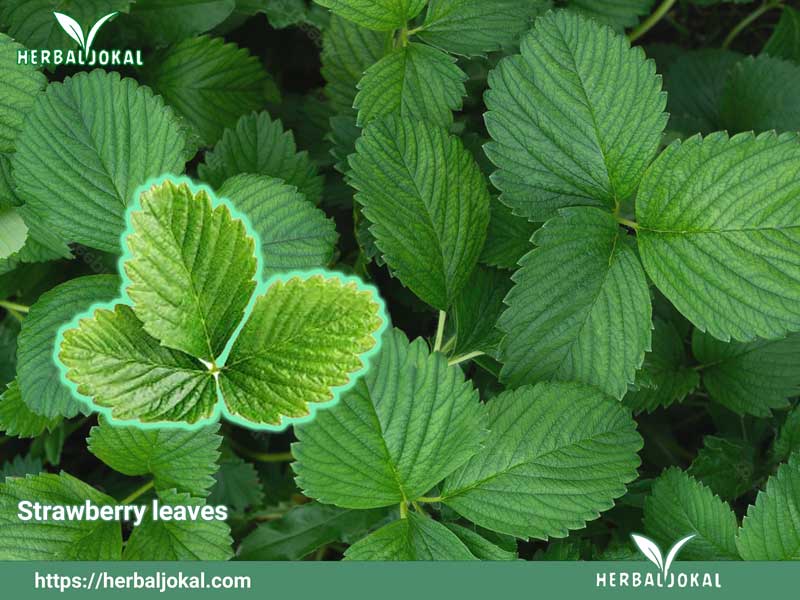Strawberry leaves are highly nutritious and are an important ingredient in natural medicines and cosmetics.
Wild strawberry leaves are an excellent source of iron, antioxidants, vitamin C, K, and a polyphenolic compound called tannin. They also contain ellagic acid which has immune-boosting properties.
The strawberry plant is divided into three categories:
Day neutral strawberry plant:
They are not sensitive to the length of the day, so if the air temperature is between 35 and 85, they will continuously produce flowers, fruits and leading roots.
Everbearing strawberries:
This species during long summer days and short autumn days. Buds formed in summer bloom and flower in autumn, and buds that come out in autumn bear fruit in spring.
Juneberries:
They are sensitive to the length of the day, this species sprouts in autumn and flowers and fruits in spring. For a home greenhouse, we recommend Juneberries and although you have to wait a year to harvest the fruit, it is worth it.
Suitable strawberry varieties for planting:
The first step to planting healthy and good strawberries is choosing the right plants. A plant is selected for cultivation that is free from any disease and complications. The selected plant is a plant that has healthy and strong roots.
The way to recognize healthy roots is to pay attention to the color of the roots, the whiter the roots are. And they are stronger and healthier if they look brighter.
Strawberries grow naturally in some regions of Iran, including the northern regions, the slopes of Alborz and Azerbaijan.
Strawberries can be cultivated in different climatic conditions. Some strawberry cultivars that grow in the northern regions, such as F. Virginiana, can withstand the cold of -30 degrees Celsius. These cultivars are also resistant to late spring cold. Some others such as Mussuonary and Blakemor are resistant to heat and drought. Cold-sensitive cultivars tolerate up to -10 degrees Celsius during winter. In regions with cold winters, cold-resistant cultivars are usually used and plastic covers are used to protect them from the cold.
The structure of the strawberry plant with its high flexibility is strongly affected by the light and temperature conditions, as well as the agricultural and nutritional conditions can have a great effect on the vegetative or reproductive growth of this plant.
Different cultivation systems can make the plants fruitful in different seasons and regions and make it possible to produce crops throughout the year, although these systems require the use of plants and cultivars that have a suitable growth cycle and can achieve the expected performance.
75% of the country’s strawberries are produced in Kurdistan.
After Kurdistan, the provinces of Mazandaran, Golestan and Gilan are in the next places of strawberry production in the country.
Jiroft city in Kerman province, Alborz province, Tehran and Qazvin are among the major strawberry greenhouse cultivation centers in Iran.
The largest area under strawberry cultivation in the open air belongs to Kurdistan province, followed by Mazandaran and Golestan.
The largest area under strawberry cultivation in the open air belongs to Kurdistan province, followed by Mazandaran and Golestan.
We can exploit the leaves of this amazing plant in the best conditions and with good quality and offer it to the world market.
Major benefits of purchasing from our company include:
- Offices in Oman, USA, and Iran
- US Bank account
- Product Packaging customization
- Quality Assurance, in compliance with industry standards
- Free product samples
- Mutiple shipment methods:
FOB, CFR, DAP, CIF.
Cultural Info
The Blackfoot, Cherokee, Ojibwa and Iroquois Tribes in North America used Wild strawberry leaves as a disinfectant and a treatment for gastrointestinal problems. The plant as a whole is considered an antiseptic due to large amounts of tannins, and the leaves were often boiled and consumed to help purify the blood. The tribes would also chew, dry, or mix the crushed leaves with other ingredients to apply to sores and burns. In addition to the leaves, the fruit was also used for a health booster, and the aroma of the plant was used to draw in wildlife for hunting.
Strawberry leaves may improve heart health
Berries have been touted as a heart-friendly food by dietary scientists for several decades — strawberries very much included.
Berries contain lots of polyphenols like anthocyanins, which are organic compounds proven across multiple clinical trials to reduce the risk of heart complications. Many trials included strawberries, both fresh and freeze-dried, as well as liquid polyphenol extracts derived directly from strawberries.
Fun fact: The leaves of strawberries contain way more polyphenols than the flesh. If you’re using strawberries as an ingredient in, say, a hearth health-boosting smoothie, leaving on the leaves will increase the ba-thump ba-thump benefits you feel with each beat.
Strawberry leaves might reduce blood sugar
There’s evidence strawberry leaves reduce blood sugar levels. This is great for folks with conditions like type 2 diabetes who carry a higher risk of hyperglycemia (aka dangerously high blood sugar levels).
Polyphenols can tip their hat again here — they’re behind this benefit too. Clinical trials like this one from 2015 found strawberry leaf extract high in polyphenolic compounds significantly reduced blood glucose levels in rats with diabetes. Rat’s obvi aren’t people, so human trials are very much needed, but the results are promising.
The theory is that polyphenol-rich strawberry leaves influence carbohydrate digestion and absorption, and as a knock-on effect help keep blood sugar levels under control.
Are strawberry leaves the future of type 2 diabetes treatment? Probably not, but having a bowl of leafy strawberries after a high-carb meal like pasta is already being recommended by some dietitians.
Strawberry leaves reduce oxidative stress
It’s no news that strawberries are swimming in antioxidants, but the fact most are found in the leaves and not the fruit might come as a surprise.
Researchers estimate that the antioxidant capacity of strawberry leaves is up to six times higher than the flesh of the berry itself. This isn’t just true for strawberries either — research from 2016 suggests that leaves are where the antioxidant party tends to be for most berries.
The bioactive compounds (those lil polyphenols again) found in strawberry leaves can help reduce free radicals that cause oxidative stress.
Just like every benefit on our list, if you’re using strawberries for an antioxidant boost, leaves-on is the way to go.
Strawberry leaves boost your immune system
Vitamin C is one of the most important vitamins for a healthy immune system. Good thing that strawberry leaves are almost as rich in vitamin C as the berry bit of the plant then, isn’t it?
It varies plant to plant, but a 100-gram (g) serving of strawberry leaves contains an average of 138 milligrams (mg) of vitamin C, not much lower than the 224 mg in 100 g of the fruit.
Strawberries continue to be investigated for their benefits as an immune-boosting functional food. The combo of vitamin C and polyphenols is known to help the body maintain its defenses.
Regular strawberries in your diet could help keep those sick days down, and including the leaves will only increase the benefits.
Strawberry leaves might have anti-microbial properties
There’s some evidence that strawberry leaves have anti-microbial properties too. But more research is needed to confirm if it’s true and, if it is, whether these effects are enough to make a song and dance about.
As it stands, some research has found that strawberry extracts inhibit the growth of various viruses, bacteria, and pathogenic microbes. The evaluation used strawberry extracts though, and while investigations like this one from 2014 suggest the chemical composition of strawberry leaves is a recipe for anti-microbial benefits, studies that test this theory are still scarce.
Ways you can use strawberry tops and leaves
The easiest way to get strawberry leaves into your system is to eat strawberries and leave the leaves on. Pretty easy.
But if you want to use them as an ingredient on their own, you def can. You can find dried strawberry leaves and liquid strawberry leaf extract online or at health food stores.
As for foods and recipes you can add strawberry leaves to, here are a few of our faves:
Make strawberry leaf tea
Herbal teas are good for the body and soul, and dried strawberry leaves can be added for both an additional health boost and for a bit of mild fruity flavor.
Whip up a smoothie
Strawberries go great in smoothies, and so do their leaves! You can add a bit of strawberry leaf to your smoothie by leaving the leaves on the strawberries you already include, or adding a little dried leaf or extract to your mix.
They work with green smoothies too, especially as an added kick for a kale–spinach combo.
Toss them in a salad
Fresh strawberry leaves make a great addition to leafy salads. The flavor’s light, so it won’t overpower the hero of your dish, but it’ll add a grassy, fruity edge that’ll bring out both the natural earthy undertones and zesty fruity currents in your other ingredients.
Add ’em to your booze
If you’re looking for a little extra something for your mojito or summertime cocktail, strawberry leaves work wonders. To make life extra easy you can use strawberry tops saved from strawberries you eat (if you don’t want to eat the leaves).
Source:
- https://www.specialtyproduce.com/produce/Strawberry_Leaves_10674.php
- https://greatist.com/eat/strawberry-leaf-benefits#benefits
- https://academic.oup.com/nutritionreviews/article/68/3/168/1910550?login=false
- Basu A, et al. (2010). Berries: Emerging impact on cardiovascular health.
academic.oup.com/nutritionreviews/article/68/3/168/1910550 - Ferlemi A, et al. (2016). Berry leaves: An alternative source of bioactive natural products of nutritional and medicinal value.
ncbi.nlm.nih.gov/pmc/articles/PMC4931538/pdf/antioxidants-05-00017.pdf - Ibrahim D, et al. (2015). Effect of strawberry (Fragaria × Ananassa) leaf extract on diabetic nephropathy in rats.
ncbi.nlm.nih.gov/pmc/articles/PMC4459800/ - Karlund A, et al. (2014). Polyphenols in strawberry (Fragaria × Ananassa) leaves induced by plant activators.
pubs.acs.org/doi/full/10.1021/jf405589f - Michalska A, et al. (2017). Profiles of bioactive compounds in fruits and leaves of strawberry cultivars.
content.iospress.com/articles/journal-of-berry-research/jbr146 - Seleshe S, et al. (2017). Evaluation of antioxidant and antimicrobial activities of ethanol extracts of three kinds of strawberries.
ncbi.nlm.nih.gov/pmc/articles/PMC5642802/ - Yadav Y. (2021). Potential benefits of berries and their bioactive compounds as functional food component and immune boosting food.
taylorfrancis.com/chapters/edit/10.1201/9781003242604-7/potential-benefits-berries-bioactive-compounds-functional-food-component-immune-boosting-food-ritika-yadav - Zlabur J, et al. (2020). Biological potential of fruit and leaves of strawberry tree (Arbutus unedo L.) from Croatia.
ncbi.nlm.nih.gov/pmc/articles/PMC7663455/ - https://niewczas.co/en/offer/types/frigo




Reviews
There are no reviews yet.